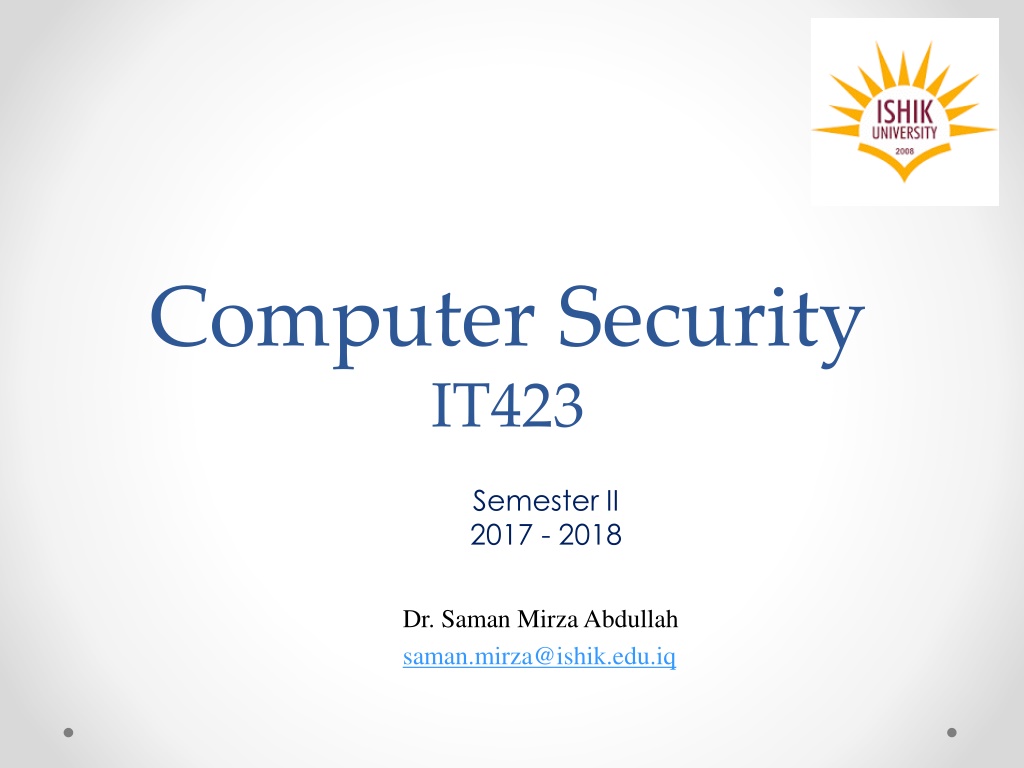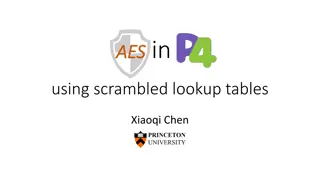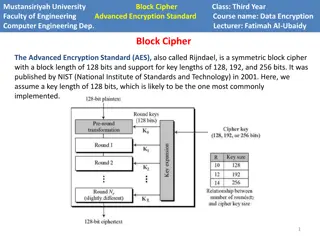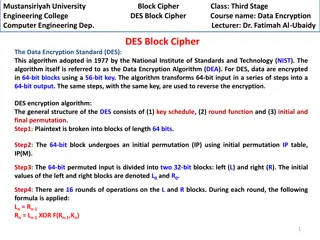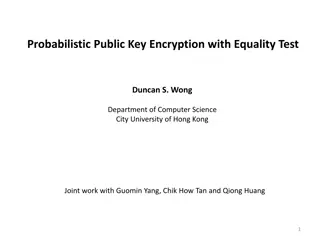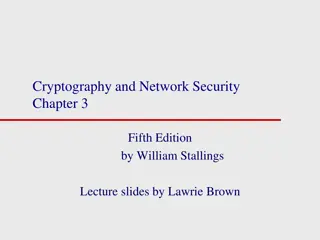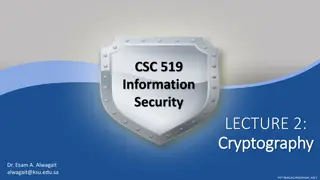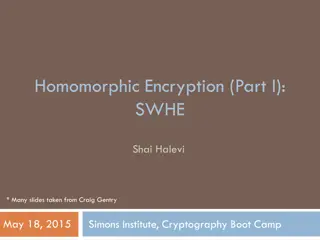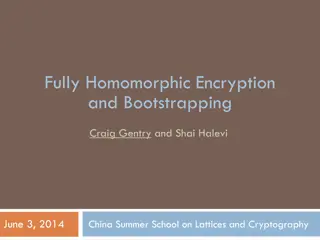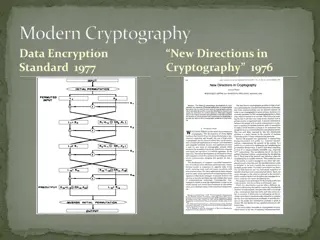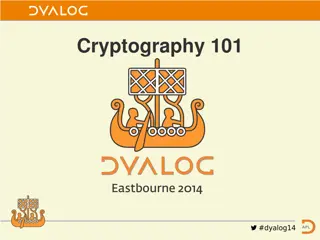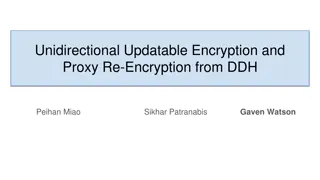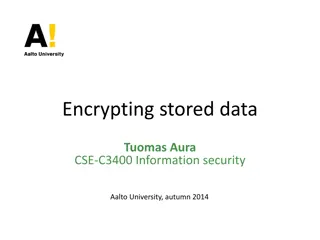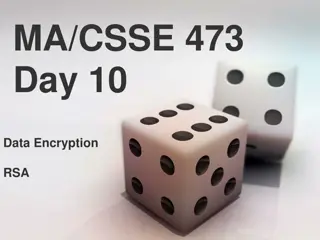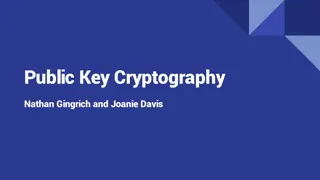Overview of Data Encryption Standard (DES)
Data Encryption Standard (DES) is a symmetric-key block cipher created in 1973 by NIST. It uses a 64-bit plaintext to generate a 64-bit ciphertext and vice versa. The same 56-bit cipher key is employed for encryption and decryption, utilizing rounds with S-box and P-box steps, ensuring confusion and diffusion. Learn about the history, structure, and objectives of DES in this comprehensive guide.
Uploaded on Mar 04, 2025 | 0 Views
Download Presentation

Please find below an Image/Link to download the presentation.
The content on the website is provided AS IS for your information and personal use only. It may not be sold, licensed, or shared on other websites without obtaining consent from the author.If you encounter any issues during the download, it is possible that the publisher has removed the file from their server.
You are allowed to download the files provided on this website for personal or commercial use, subject to the condition that they are used lawfully. All files are the property of their respective owners.
The content on the website is provided AS IS for your information and personal use only. It may not be sold, licensed, or shared on other websites without obtaining consent from the author.
E N D
Presentation Transcript
Computer Security IT423 Semester II 2017 - 2018 Dr. Saman Mirza Abdullah saman.mirza@ishik.edu.iq
Data Encryption Standard (DES) Computer Security - Ishik 3/4/2025 2
Class Objective The main objective of this class is to: o To review a short history of DES o To define the basic structure of DES o To describe the details of building elements of DES o To describe the round keys generation process Computer Security - Ishik 3/4/2025 3
Confusion and Diffusion confusion o Make relation between statistics of ciphertext and the value of the encryption key as complex as possible. diffusion o Diffuse statistical property of plaintext digit across a range of ciphertext digits Each plaintext digits affects value of many ciphertext digits, or has same relation with many ciphertext digits. Computer Security - Ishik 3/4/2025 4
Feistel Cipher It is a design model, not specific method. Uses same algorithm for encryption and decryption. Has multiple round of processing plaintext. Each round consists S-box and P-box step. Computer Security - Ishik 3/4/2025 5
DES The Data Encryption Standard (DES) is o a symmetric-key block cipher published in 1973 by the National Institute of Standards and Technology (NIST), as a proposal. o It has been accepted by as a draft of the Federal Information Processing Standard (FIPS), in March 1975 . o Although the draft was criticized, on 1977 the drafted has been published. Computer Security - Ishik 3/4/2025 6
Overview DES takes: o A 64-bit plaintext and creates a 64-bit ciphertext; at the decryption site, o A 64-bit ciphertext and creates a 64-bit block of plaintext. o The same 56-bit cipher key is used for both encryption and decryption. Computer Security - Ishik 3/4/2025 7
DES Structure Encryption Has two P-boxes: o Initial and final permutation. o Each is inverse to the other. Has 16 rounding or (S-box). Accepts 64 bit Plaintext. Has 56 bit cipher key, 48 bit used. o Based on some predefined algorithms. Computer Security - Ishik 3/4/2025 8
DES Structure Encryption / (P-box ) Has two P-boxes: o Initial and final permutation. o Each is inverse to the other. It is applied directly on 64 bit of the plaintext. They are keyless. Increases the role of hardware in encryption process. Computer Security - Ishik 3/4/2025 9
DES Structure Encryption / (P-box ) Find the output of the initial permutation box when the input is given in hexadecimal 0x0002 000 0000 0001 We have only the 15th bit and 64th bit are one. 15 63 64 25 Computer Security - Ishik 3/4/2025 10
DES Structure Encryption / (P-box ) Find the output of the Final permutation box when the input is given in hexadecimal 0x 0000 0080 0000 0002 We have only the 25th bit and 63rd bit are one. 63 15 25 64 Computer Security - Ishik 3/4/2025 11
DES Structure Encryption Done What are going on inside the rounds? Done Computer Security - Ishik 3/4/2025 12
DES Structure Encryption / Rounds The input to the rounds will be divided into two parts (Left and Right). The round has Swapperand Mixer processes. Swapper inverted the right half of the input with left. Mixer uses a Function to mix the first half with a key. ?(?? 1,??) Computer Security - Ishik 3/4/2025 13
DES Structure / Rounds/?(?? 1,??) This Called the DSE function. It is the hart of the DES structure. It is apply a 48 bit key to the 32 bit input. Always the rightmost bit. It gives at output 32 bit. It comes in different steps. Computer Security - Ishik 3/4/2025 14
DES Structure / /?(?? 1,??)/????? These steps are occurred in the DES Function o Expansion D-box. o Whitener XOR o S-Box o Straight D-box Computer Security - Ishik 3/4/2025 15
?(??1,??)/????????? Why Expansion is needed? Input to the round steps has 32 bits size, the Key has 48 bits. So, expansion needed. Computer Security - Ishik 3/4/2025 16
?(??1,??)/????????? Input will be divided into 8 sections. Each 4 bit section expends to 6 bits section. four bit Computer Security - Ishik 3/4/2025 17
?(??1,??)/Whitener XOR Computer Security - Ishik 3/4/2025 18
? ??1,?? /? ????? S-boxes are doing real mixing. (Confusion). DSE has 8 S-boxes, each. o Has 6 inputs and 4 outputs. How the process is going on inside each S-boxes. Computer Security - Ishik 3/4/2025 19
? ??1,?? /? ????? For each S-box, we have a truth table. The truth table for S-box 1 is differ from others. There is no similar truth table among the eight boxes. Computer Security - Ishik 3/4/2025 20
? ??1,?? /? ????? Use the S-box below to get the output of the 110001 The 1st bit is (1) and the 6th bit is (1), so the row is 11 which means (3) The rest of the bits are (1000) which means (8). The box with index (3,8) has a value of (05). Converting (05) to binary, it will be (0101). Computer Security - Ishik 3/4/2025 21
? ??1,?? ?????? ? ??????????? It is the final stage of DES function. Sometimes called as Final Permutation. It is the 32 bits input / 32 bites output permutation operation. It follows a straight permutation truth table, as shown below: According to the above table, the 7th bit of the input will be the 2nd bit of the output. Computer Security - Ishik 3/4/2025 22
Key Generation First step is Parity drop: o Removing the parity bit. (if Available). o Do permutation according to a give table. o Output is 64 bits input becomes 56 bits. Divide the 56 bits into two parts, each 28 bits. o Left part and right part. o Do left bit shifting. Given permutation / compression table, do permutation to reduce the size to 48 bits. Computer Security - Ishik 3/4/2025 23
Key Generation Example A 10 bits key is shared between sender and receiver. Use the following information to generate K1 and K2, which each has 8 bits sizes. K=(10100 00010) is the main key. No parity bits are there. P10 permutation is (3 5 2 7 4 10 1 9 8 6) P8 permutation is (6 3 7 4 8 5 10 9). o o o o ========================================== o No parity bits will be removed. o P10 (K) = P10 (10100 00010) = (10000 01100). o Left part is (10000) and Right part is (01100). o Applying left shifting on both part L = 00001 and R = 11000. o Combining the L and R = 0000111000 o P8( L and R) = P8 (00001 11000) = (10100100) o Therefore, the sub-key k1 is (10100100) Computer Security - Ishik 3/4/2025 24
Key Generation Example o No parity bits will be removed. o P10 (K) = P10 (10100 00010) = (10000 01100). o Left part is (10000) and Right part is (01100). o Applying left shifting on both part L = 00001 and R = 11000. o Combining the L and R = 0000111000 o P8( L and R) = P8 (00001 11000) = (10100100) o Therefore, the sub-key k1 is (10100100) With which of the above information we should start for computing the set values of sub-key k2? Computer Security - Ishik 3/4/2025 25
Key Generation Example o No parity bits will be removed. o P10 (K) = P10 (10100 00010) = (10000 01100). o Left part is (10000) and Right part is (01100). o Applying left shifting on both part L = 00001 and R = 11000. o Do left shifting bit. o L=00010 and R= 10001 o Combining the L and R = 00010 10001 o P8 permutation is (6 3 7 4 8 5 10 9). o P8( L and R) = P8 (00010 10001) = (10010010) o Therefore, the sub-key k1 is (10010010) Computer Security - Ishik 3/4/2025 26
Quiz ? When need to find the sub-key K3, o Which information will be taken in consideration? o Dose the process of round 3 will go as round or not? If any change is there show and highlight the change. Computer Security - Ishik 3/4/2025 27
Read More The DES Algorithm Illustrated.pdf in the same folder. Computer Security - Ishik 3/4/2025 28
Class End Computer Security - Ishik 3/4/2025 29
